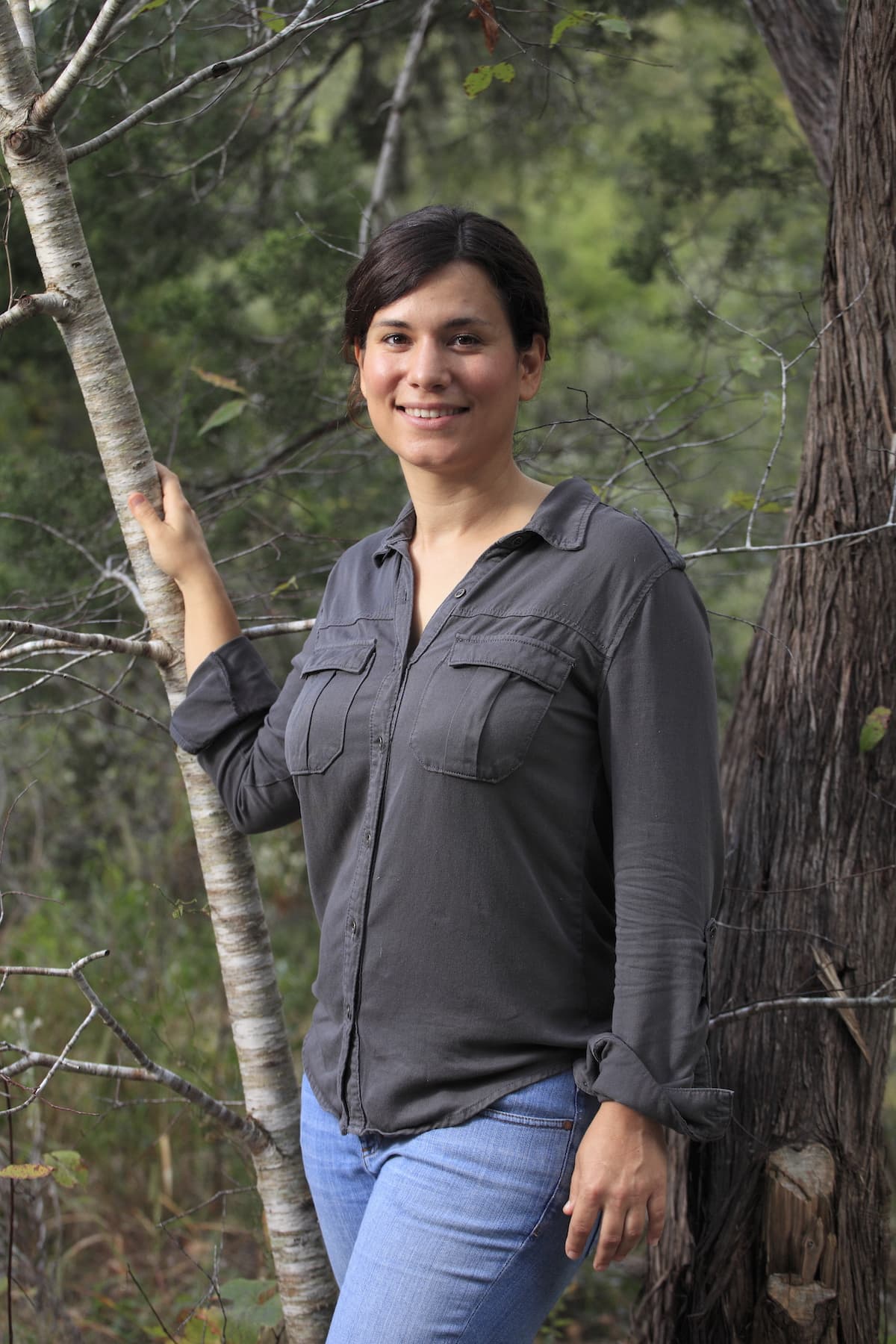
Sarah Galvan
SPECIALTY: Native Plants
ABOUT:
Sarah Galvan has been passionate about gardening since she was a child. She’s an arborist, herbalist, Texas master naturalist, a former SAWS conservation consultant and holds native landscape certification. Galvan worked as a native landscape designer where she focused on supporting native bird and pollinator populations. When she’s not answering gardening questions or working on her biology degree, Galvan enjoys hiking, kayaking, bird and butterfly watching, and competing in plant identification competitions.
Related Article

-
Sow sumac for seasonal color
Texas may not be known for its seasonal color, but in winter we have sumac. Its rust-red fruit summons song and game birds to its woody branches. Note: In celebration of central Texas’ tree-planting season from October to February, this occasional series will highlight a few favorite trees for cultivating more shade in the residential […]
-
Last chance to plant spring wildflowers
This may be fallen leaves and pumpkin season, but there is still time to plant wildflowers! If summer 2023 left your landscape with sunny bare patches, sowing wildflower seeds can be a fun option for the family to enjoy. Wildflower packets may say to plant in early fall, but in South Texas — where temperatures […]
-
Design a Rain Garden Using WaterSaver Coupons
Want to build a rain garden, but not sure where to start? Consider your landscape’s sun and shade situation before you pick your plants. With all the rain we’ve been getting — and the possibility of more on the way — it may be a good idea to invest in a rain garden. Rain gardens […]
-
Protect Our Precious Pollinators
Planting pollinator-friendly plants is just one way to attract these flora fertilizers. We’ve compiled a few more tips to help get you started. Did you know pollinating insects are responsible for the pollination of 75 percent of food species that are consumed by humans? That’s right folks, without these species our favorite foods may not […]
-
Liven Up your Garden: Plant Early Spring Bloomers
Plant the beauty of an early Texas spring. Ornamental trees and shrubs are among the first to flower and provide nectar sources for pollinating insects and hummingbirds. One of the keys to successful gardening is seasonal interest. It’s important to utilize plants that keep your garden visually appealing all year. To capture the beauty of […]
-
Plan Ahead for a Colorful Winter Garden
Evergreen plants and a few colorful winter performers are all your landscape needs to cast a colorful glow in the colder months. See our list of recommendations. Missing warm color in the garden this winter? Don’t let the brown bring you down. When planning a garden, it’s important to consider seasonal interest. Be conscious of […]
-
Pick a Peck of Pollinator Plants
Use our list of butterfly-approved plants and you may even attract bees and birds, too! Are you looking to improve your landscape for wildlife but don’t know the first thing about butterfly gardening? Providing nectar sources for butterflies is very important due to habitat loss and increased use of pesticides in crop fields. Do your […]
-
Know your Natives: Sideoats Grama
This warm-season, deep-rooted, sun-loving bunchgrass grows in every ecoregion across Texas. It not only perseveres in all seasons, but sideoats grama also thrives without any additional water! During the hottest months of the year when many other commonly used plants are shirking from the blazing heat, sideoats grama is boasting beautiful, ornamental inflorescence. This warm-season, […]
-
Work With Nature, Not Against It
Sun-loving turf will never thrive in deep shade, no matter what you do to it. Replace problem areas with native plants from the WaterSaver Landscape Coupon. There are more than 100 gorgeous options! A common complaint I hear from customers is the inability to grow grass under the dense shade of live oaks. Many homeowners […]
-
Know Your Natives: Texas Vervain
This native, perennial prairie plant provides plentiful pollen and spring nectar to our favorite little pollinating friends. Wondering what that delicate spike of tiny purple flowers elegantly blowing in the gentle spring breeze is? That, my gardening friends, is an unsung landscape hero — a native and perennial prairie plant that provides plentiful pollen and […]
-
Plant a Hummingbird Garden Using the WaterSaver Landscape Coupon
Roll out the welcome mat for our warm season avian friends! These coupon-qualified cultivars are all you need to successfully attract hummingbirds to your yard. With the onset of warmer days comes beautiful blooms, colorful butterflies and the return of many of our warm season avian friends — especially the many hummingbirds that arrive in […]
-
Gardening in Full Sun with the WaterSaver Landscape Coupon
Shade in short supply? The plants you pick for a sunny spot must be able to handle sporadic rainfall and scorching summer heat. The WaterSaver Landscape Coupon can help you choose plants that are up to the task. Gardening in central Texas in full sun is no joke. The plants you choose must be able […]
-
What To Plant for Winter Bloom
If you’re looking for winter blooms, there are many plants — including several that are native — that would make great additions to your winter garden. Are you the kind of gardener who must have flowers all year? No need to purchase fake flowers. With a little knowledge, you can have flowers this winter! Paperwhites […]
-
How To Lower Your Water (and Sewer) Bills
Your landscape is your single biggest water user. So turning your irrigation system off now, when the lawn is dormant and your sewer charge is being set for next year, is a surefire way to save water and money. This time of year is your best opportunity to save water and money. Do you know why? Your […]
-
Get a Jump on Winter Weeds
Winter weeds can be an issue in our lawns, but a proactive management plan will limit their germination and growth throughout the dormant season. Fall and winter in South Texas means a break from the sweltering heat and humidity, but don’t get too comfortable — annual winter weeds are paying your yard a visit this […]
-
If You Plant It They Will Come
The milder weather is magnificent motivation to make your garden more hummingbird friendly. And SAWS WaterSaver Landscape Coupons can help you provide the perfect habitat for these mini flying acrobats. Did you know that planting nectar sources for animals such as hummingbirds is an incredibly effective tool for attracting them? That’s right folks, you can […]
-
Rain Garden Primer
A rain garden, with its verdant pools and lush-looking vegetation, can evoke images of an unexpected oasis in our often-arid climate. But did you know rain gardens are also good for the environment? What is a rain garden and why should I plant one? A rain garden is a shallow, vegetated depression, usually 6-9 inches […]
-
Know Your Natives: Skullcaps
Low-growing, low-maintenance and colorful, there are three skullcap species that are just right for your landscape — whether it’s in full sun or partial shade. Looking for low-growing, low-maintenance, colorful perennial fillers for your landscape? Look no further than your local nursery for these cheerful, well-behaved and drought tolerant perennials. There are three perennial species […]
-
Where There’s Smoke…
Looking for a little sizzle to light up your landscape? Spark a blaze of five-alarm charm with the hottest-looking tree you’ve never heard of: the American smoke tree American smoke tree (Cotinus obovatus), not to be confused with the European smoke tree, grows in disjointed populations in the east-central part of the United States with its […]
-
Know your Natives: Ashe Juniper aka “Mountain Cedar”
To keep or not to keep: that is the question every homeowner must answer themselves when it comes to ash juniper in the landscape. Growing up in the Hill Country, I still refer to ashe juniper, Juniperus ashei as “cedar.” But this native and ubiquitous tree is not a true cedar at all. In fact, it’s of the […]
-
Know your Natives: Dotted Gayfeather
Dotted gayfeather is commonly grown for fresh and dried flower arrangements, but it can be even more beautiful and beneficial in your garden. Liven up your late-summer garden with dotted gayfeather: a stalwart, deer-resistant and drought-tolerant performer in well-drained soils! Liatris punctata, or dotted gayfeather, is commonly grown as a cut flower for fresh and […]
-
Know your Natives: Dwarf Palmetto
Its name means small in size, but the dwarf palmetto packs a big drought-tolerant punch! And it’s a unique evergreen addition to your garden. Is your garden in need of an evergreen plant that can handle variable soil moisture and lighting conditions? Meet the dwarf palmetto, also known as Sabal minor. You may have seen this […]
-
Plant a Hummingbird Garden Using the WaterSaver Landscape Coupon
Roll out the welcome mat for our warm season avian friends — especially the hummingbirds! These coupon-qualified cultivars are all you need to successfully attract hummingbirds to your yard. With the onset of warmer days comes beautiful blooms, colorful butterflies and the return of many of our warm season avian friends — especially the many […]
-
Know your Natives: Damianita
When it comes to low maintenance, damianita reigns! Plant this drought-mocking native and you will have a bright display of color, texture AND butterflies! Nothing shouts spring more than a plant with bright yellow blossoms and evergreen foliage. Bonus if the plant is deer-resistant and appealing to butterflies. Meet Damianita (Chrysactinia mexicana), a cheerful, yellow-blossomed […]
-
Best Butterfly Plants for Central Texas
Providing nectar sources for butterflies is important due to habitat loss and increased use of pesticides in crop fields. You can do your part to provide sanctuary for these insects — and save water while doing so. Are you looking to improve your landscape for wildlife but don’t know the first thing about butterfly gardening? […]
-
What’s Wrong with My Cactus?
No, that’s not cotton candy clinging to the pads of your prickly pear plant. It’s actually a harmless scale insect that not only feeds on the plant’s moisture and nutrients, but is also used to produce a brilliant (Christmas) red dye. It’s a common sight in San Antonio, that white cottony substance on the pads […]



